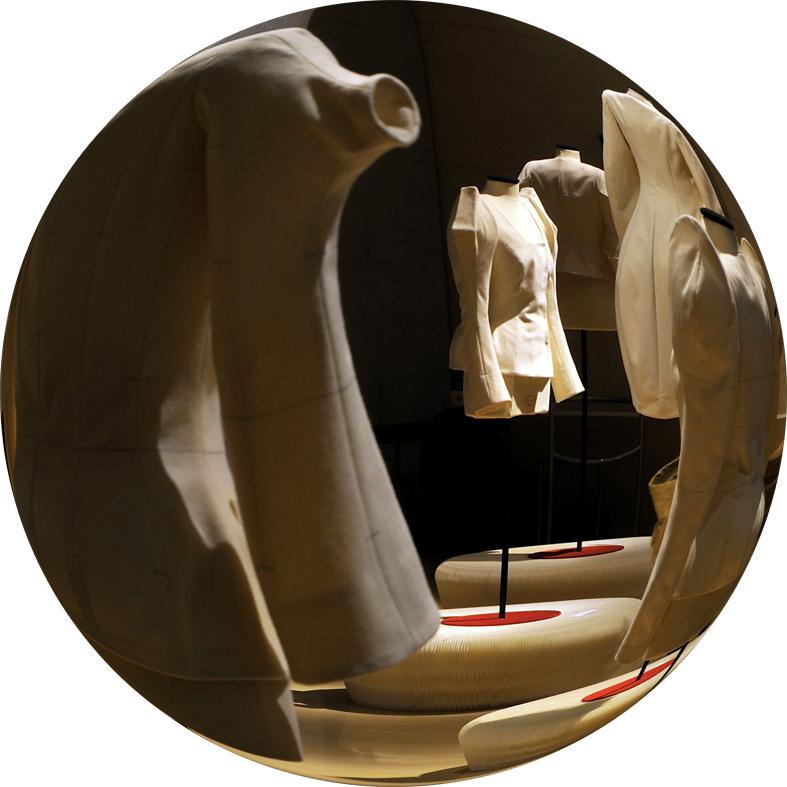Special Exhibition "Anthropometria: Mode & Science III by Naoki Takizawa"
2013.03.21-2013.10.27
MODULE
The University of Tokyo holds a collection of plaster models of three-dimensional functions made in Germany between 1880 and 1890. This collection totalizing over 200 items, acquired and brought back to Japan by Senkichi Nakagawa, a Professor of Mathematics at the Imperial University who was studying in Germany during the Taisho era, is considerably rare even on an international scale. Diverse and varying curves characterize each of these objects. By transferring them to the realm of fashion according to high-level patterning and sewing techniques, we would like to reconsider again the fundamental issue of the human body, its forms and movements, an eternal problem facing every artist.
It is the artist Yves Klein who used the word “Anthropometria” (literally “the measure of the human body”) in the field of the plastic arts. In the 1960s, he produced paintings by applying the IKB (International Klein Blue), an industrial pigment he named himself, to the naked bodies of women, pressing them on a canvas and making them roll over. He entitled these paintings Anthropométrie. In Japan, where the traditional stamping technique of takuhon (stone rubbing) exists, Klein’s title was once translated as jintaku (literally “stamping of the human body”). Among the exhibits presented here, the frames which once contained tattooed skin specimens from the Specimen room of the Faculty of Medicine now enclose slight human shadows on the remaining mounting papers, shadows which are precisely jintaku heralding the advent of the Anthropométrie series. Klein’s work prefigures happenings in that it is a one-time artistic production, and as such it already has a legendary status in the world of art. Moreover, insofar as it has been a significant attempt at reducing human corporality on the bi-dimensional scale of the canvas, Klein’s work has considerably expanded the realm of possibilities for the artistic endeavors to come.
Now, artists are not the only ones to show an interest in the morphology, the functions and the movements of the human body. How to wrap a human body with textile, protecting it, keeping it warm, adorning it, showing it and enchanting it: such a fundamental issue is precisely one that fashion creators, preoccupied with three-dimensional formal creation, cannot avoid facing. When applying textile on the human body, fixing it with pins and transferring it on patterns, the designer’s thought is constantly motivated by the appropriate method of transposing the forms of the human body on textile. When recreating these complex curvatures on textile, an accomplished technical mastery of patterning skills, as well as the assemblage of each element based on sophisticated contracting and sewing techniques are necessary. If the production of artworks is supported by a thought process that can be qualified as form-making, then what supports clothing production is a pattern-making thought process, as well as sewing techniques. Once the complex expressions of the three-dimensional mannequin have been transposed on a bi-dimensional sheet of paper, what remains of that process is the pattern. Apart from the completed actual clothes, it is on the patterns themselves that we find, in a concentrated form, the definitive results of the patterner’s pattern-making thought process elaborated in the expectation of the final sewing process.
In such a context, our aim is to differentiate between the diverse surfaces of complex forms, thereby approaching the methodology employed in analytical geometry under the control of mathematical reason. Or, to state it in other words, we wish to see applied an intellectual process that is reverse to that of the anthropometric method, in which the complex forms of the human body are transferred to a bi-dimensional surface according to direct printing techniques.
Fashion and mathematics. Such a relationship may appear quite distant to most people. However, it is precisely by overcoming such categorizations that a new methodology, a new manufacturing process is born. This time, in our attempt to investigate the frontiers of Fashion and Science, geometrical models from the 19th Century served as an important design resource. Unexpectedly, the beauty contained in a mathematical solution is quite close to that which can be seen in the realm of fashion. To demonstrate such a fact is our present intention.

